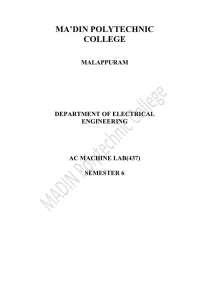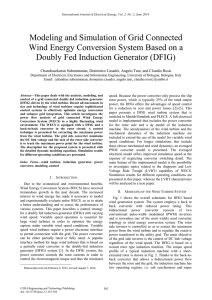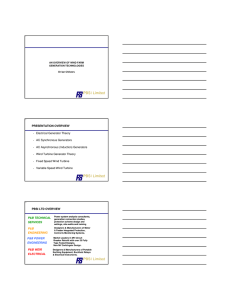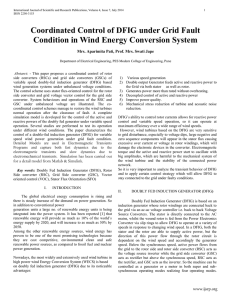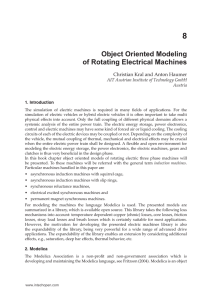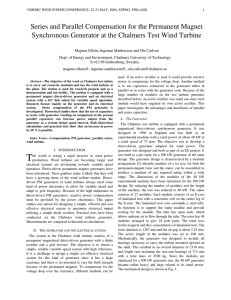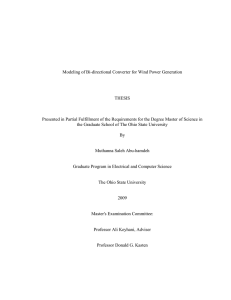Excercise 5 : The Synchronous Machine
advertisement
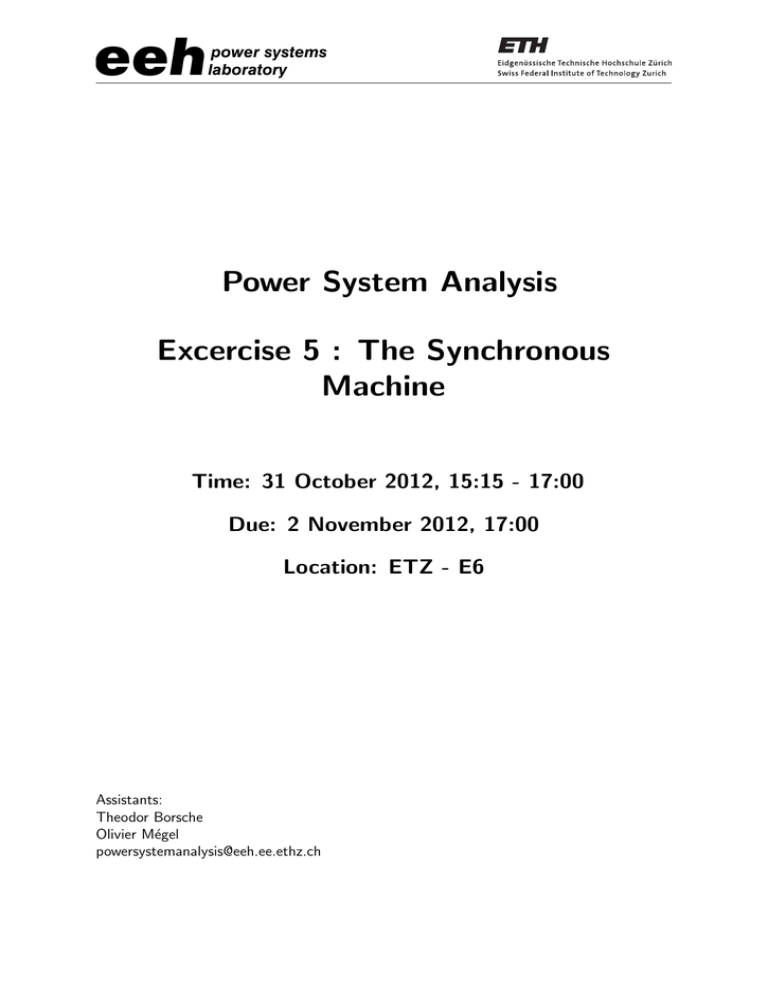
eeh
power systems
laboratory
Power System Analysis
Excercise 5 : The Synchronous
Machine
Time: 31 October 2012, 15:15 - 17:00
Due: 2 November 2012, 17:00
Location: ETZ - E6
Assistants:
Theodor Borsche
Olivier Mégel
powersystemanalysis@eeh.ee.ethz.ch
General remark: A slightly different convention is used in this exercise set compared to the
lecture notes. The only difference is that Is is here expressed with the positive counterclockwise convention (just like the other phasors). For instance in the first exercise (6 -60◦ ) the
current phasor is in the bottom right quadrant.
Round Rotor
(all units are in p.u. if not stated otherwise)
1. Given a round-rotor generator with terminal voltage U = 1.06 0◦ , reactance Xd = 1.6,
stator current I s = 1.06 -60◦ and the induced voltage E. Furthermore, a resistance
r = 0.004 is considered to account for copper losses.
a) Draw the stationary single phase equivalent circuit.
What is the connection between stator and rotor?
b) Draw the phasor diagram qualitatively without calculating the actual value of E.
Does the generator deliver or consume active/reactive power and why?
c) Find the value of the induced voltage E.
Why can we neglect r?
In the following resistance r is to be neglected (because of the results in (c)). Furthermore assume, that the magnitude of the induced voltage E is proportional to the
rotor current Ir = 1000A (actual)(|E| = const· Ir , no saturation).
d) Suppose there is a symmetric 3-phase short circuit at the generator terminals.
Draw the stationary single phase equivalent circuit and find the steady-state shortcircuit current (only its magnitude!), assuming that Ir does not change from its
pre-fault value.
Determine also the angle difference between the short-circuit current and the
induced voltage E.
2
Steam valve
Ir
T
S
R
Steam
Turbine
Generator
R S T
U
R
U∞
R
R
Is
Circuit braker
Figure 1: Thermal power system connected to a large system
2. Now, according to figure 1 another round rotor generator (|E| = const · Ir , Xd = 1.6)
should be synchronized (connected) to a large system modeled by an infinite bus to
deliver a specified complex power.
To simplify the discussion we will assume that the turbine power PT of our generator
is relatively small compared to all others eminent in the network. Therefore we do not
expect to affect significantly the voltage at that bus (U ∞ ≈ constant for all phases).
a) Derive the relation:
PT
U
between the real part of the stator current Is , the bus voltage (⇔ terminal
voltage) and the turbine power PT . (For that, please take a look in the lecture
notes on p.96)
Re{I s } =
Initially, the circuit breaker is open (t = t0 ).
b) Which conditions hold for voltages U R and E R as well as the stator current I R
s?
In order to effect a smooth transition when the breaker will be closed, the following
synchronizing condition relative to the voltages U R and U R
∞ must be satisfied:
◦
6
ER = U R = U R
∞ = 1.0 0
With this condition satisfied the breaker may be closed (t = t1 ).
c) The steam valves at the turbine are then opened slowly until PT = 0.2, whereby
Ir = 1000A is kept constant. Draw the stationary circuit for phase R for this
case and find I R
s.
d) With PT unchanged, the rotor current is increased to Ir = 1600A (actual). Find
IR
s.
Does the delivery of reactive power increase or decrease?
3
Salient Pole Rotor
1. Given E = 1.56 30◦ , |E| = const· Ir , I s = 0.56 -30◦ , Xd = 1.0 and Xq = 0.6.
a) Find U .
Hint: Draw a phasor diagram.
Suppose there is a symmetric three-phase short circuit.
b) Show, that the steady-state short circuit current magnitude (for the single phase
equivalent circuit) results to |I s | = 1.5, assuming that the rotor current Ir (in
the steady state) is unchanged from its pre-fault value.
E
a'
jX q I sq
I sq
jX q I s
U
jX d I sd
I sd
Is
rI s
Figure 2: Phasor diagram of a salient pole rotor
2. In figure 2 we see the result of adding jXq I s to U + rI s .
a) Prove that we get to a point a0 , which is in the same direction as E.
Given U = 1.06 0◦ , I s = 1.06 -45◦ , Xd = 1.0 and Xq = 0.6. Neglect r.
b) Find E.
Hint: Use the result of 2(a).
4



